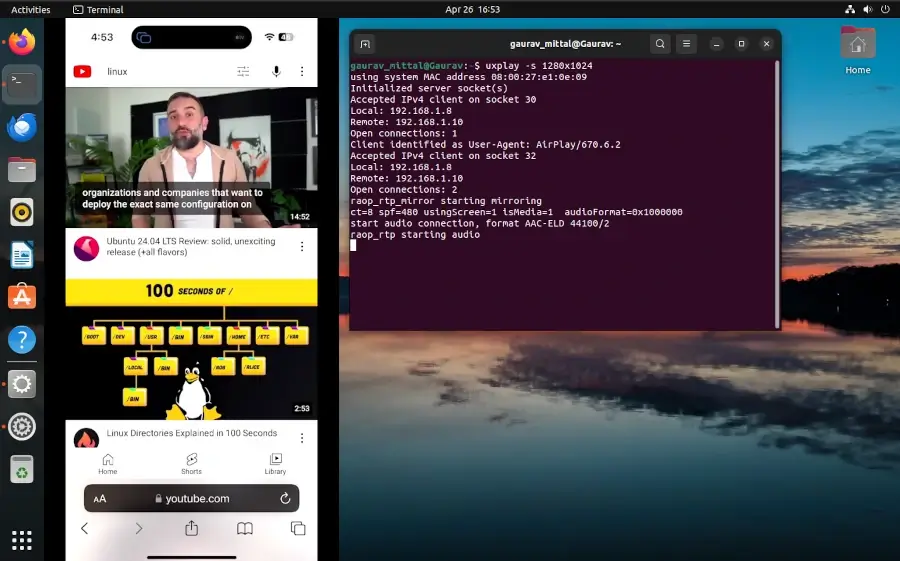Mirroring refers to displaying a device’s screen on another device’s display in real-time. It is a handy feature whether you are troubleshooting issues, presenting, playing games, or want to enjoy your media on a bigger screen.
While Android users benefit from multiple ways of mirroring their screens on Ubuntu, Apple users lack that leverage. So, in this how-to guide, we will demonstrate step-by-step how to mirror your iPhone/iPad screen on an Ubuntu desktop without any hassles.
Prerequisites
- An Ubuntu system with a Wi-Fi connection.
- An iPhone or iPad with iOS 7 or later.
- Both devices should be connected to the same Wi-Fi network.
Mirroring iPhone/iPad Screen on Ubuntu Desktop
Streaming an iPhone/iPad’s screen to an Ubuntu system has become easy. You simply need to install UxPlay, an open-source utility based on Apple’s AirPlay technology.
Airplay is a built-in feature in Apple devices that lets you share videos, audio, and photos with other Apple appliances, such as TVs and speakers.
Begin the installation by updating the apt package list and upgrading the existing packages using:
sudo apt update && sudo apt upgrade -y
After that, install uxplay through the following command:
sudo apt install uxplay -y
Furthermore, UxPlay also supports hardware-accelerated H.264 decoders to speed up media transcoding and provide top-notch performance.
For this feature to work, you must install the below GStreamer plugins.
sudo apt install gstreamer1.0-plugins-good gstreamer1.0-plugins-bad gstreamer1.0-libav -y
The above plugins work with UxPlay to facilitate high-quality and smooth audio-video rendering. However, you might still experience negligible lag and frame drops.
You are now equipped with the tools to mirror your iPhone/iPad screen on Ubuntu. So, launch UxPlay on the desktop by executing the uxplay command in the terminal.
uxplay
Open the Control Centre on your Apple device by swiping down from the top-right corner of the screen. Here, click on the Screen Mirroring icon and select UxPlay. Immediately after this, you should see your iPhone/iPad’s screen streaming onto your Ubuntu desktop.

When you wish to end streaming, disconnect it from your iPhone/iPad, close UxPlay’s window, and press CTRL + C in the terminal to end UxPlay’s process.
If you want to change its resolution, pass the intended resolution using the '-s' option.
uxplay -s 1440x900
Moreover, if you desire to use the audio-only mode, use the '-async' option while initiating the UxPlay server. This uses Apple’s Lossless Audio Codec (ALAC) to transmit the best possible audio quality. However, due to iOS’s limitations, you would receive a 2-second latency by default.
uxplay -async
You can also rotate the screen using the ‘-r L' or '-r R' options, where L and R stand for left and right.
uxplay -r L or uxplay -r R
Limitations of UxPlay
Despite all the features mentioned above, the following are a few limitations of using UxPlay mirror mode:
- You can’t play Apple TV, Netflix, Amazon Prime, or other DRM-protected applications because UxPlay can’t decrypt video DRM.
- The UxPlay mirror server does not support AirPlay2 video streaming, so you can’t open any app and click the cast icon to start streaming.
- Although Apple did not discontinue the AirPlay mirroring protocol after launching AirPlay2, they might do so in future updates, making UxPlay useless.
Mirroring a mobile device to a desktop can significantly aid in various productivity and entertainment tasks. Going through the steps mentioned above, you can easily mirror your iPhone/iPad on an Ubuntu device and enjoy the benefit of a larger screen.
Moreover, if you are a tech geek and want to configure more settings, it is recommended that you visit UxPlay’s Github repository.
